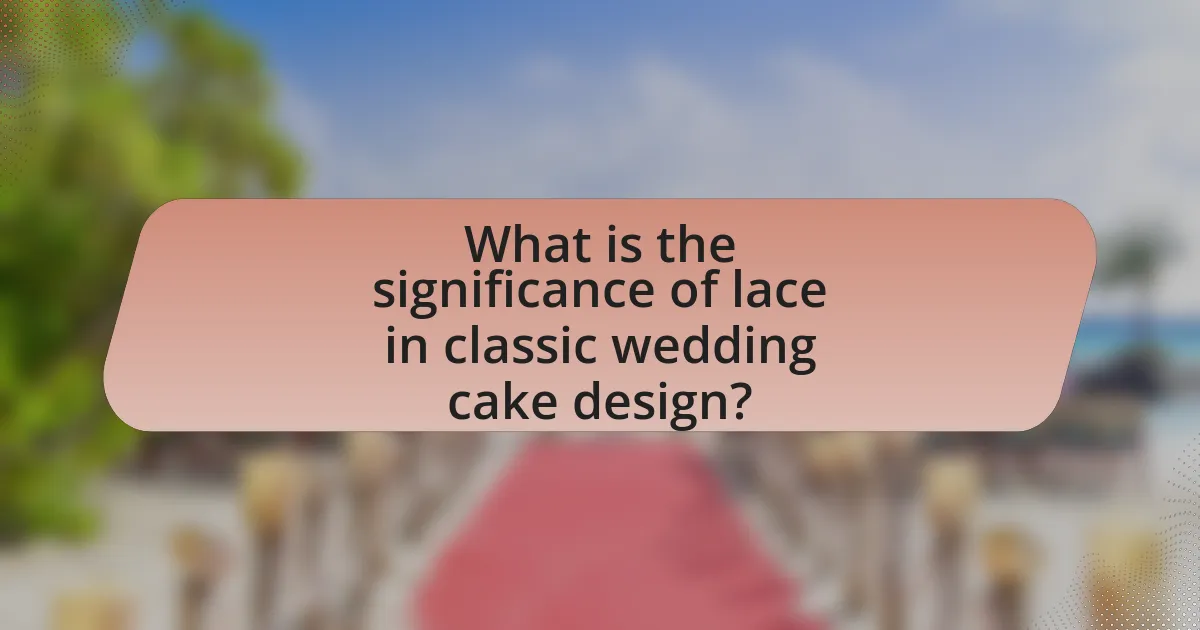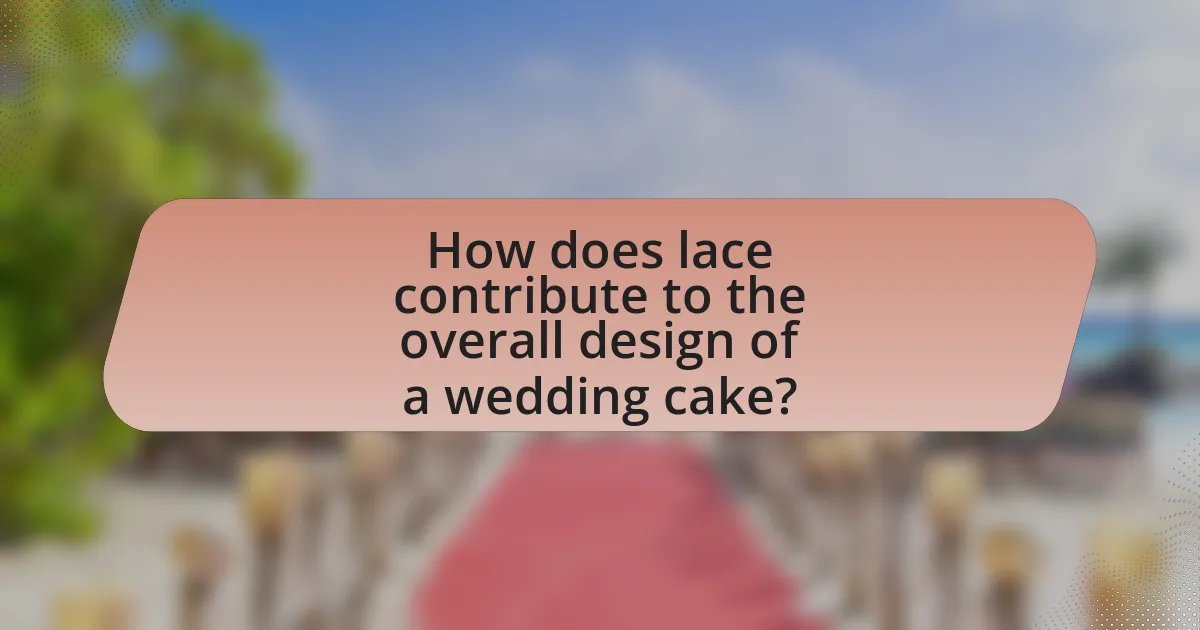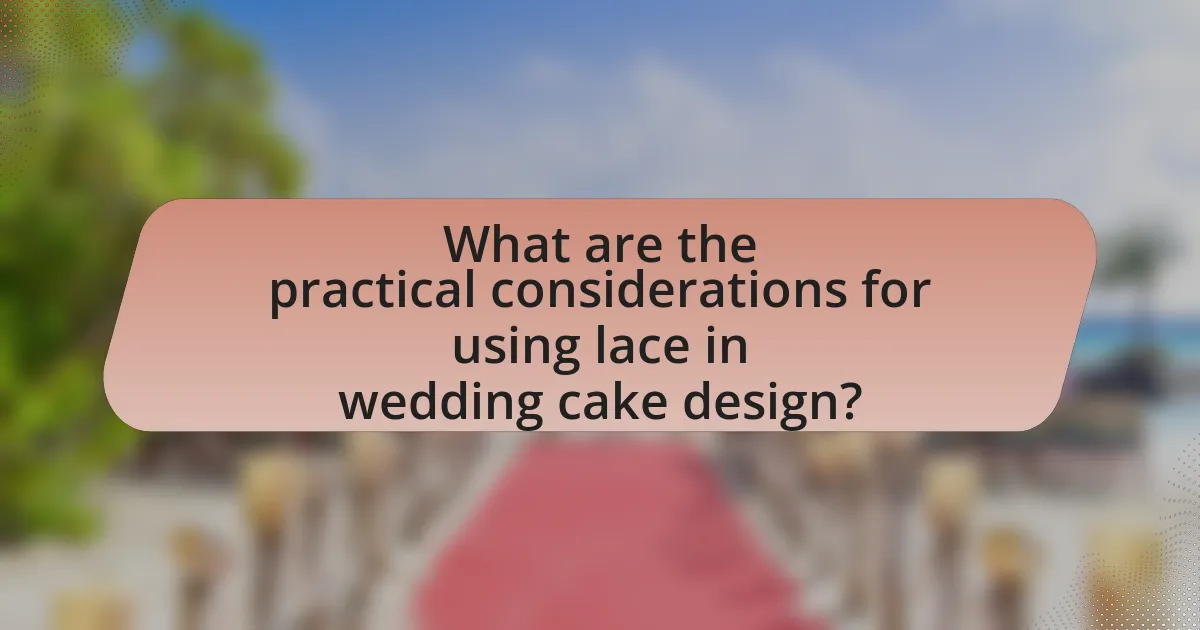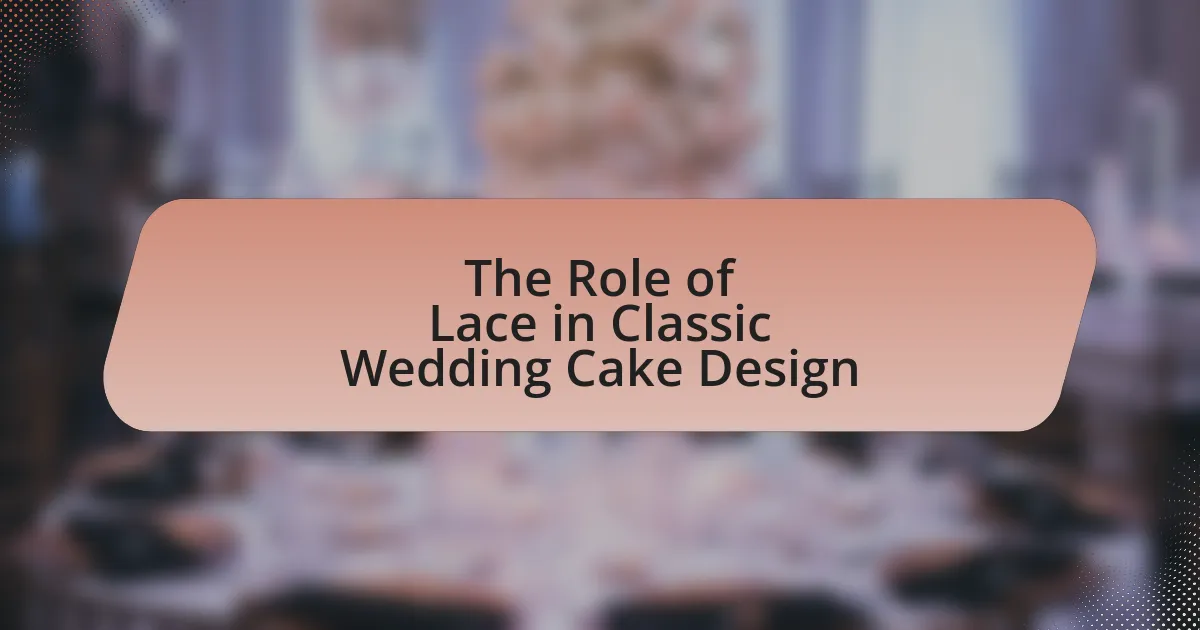Lace plays a significant role in classic wedding cake design, symbolizing elegance and sophistication while reflecting the intricate details of bridal attire. Historically associated with weddings since the 16th century, lace enhances the visual appeal of cakes through various techniques such as piping and edible lace. The article explores the historical use of lace in cake decoration, cultural influences, and the evolution of lace trends over time. It also examines the emotional themes lace evokes, its interaction with other decorative elements, and practical considerations for incorporating lace into wedding cakes. Additionally, it provides guidance for couples on selecting the right lace design to align with their wedding theme and personal style.

What is the significance of lace in classic wedding cake design?
Lace in classic wedding cake design symbolizes elegance and sophistication, often reflecting the intricate details found in bridal attire. Historically, lace has been associated with weddings since the 16th century, representing purity and refinement. The use of lace patterns on cakes, achieved through techniques like piping or edible lace, enhances the visual appeal and aligns with the overall theme of romance and celebration in weddings. This connection to bridal fashion and its aesthetic qualities solidify lace’s significance in creating a timeless and beautiful centerpiece for the occasion.
How has lace been historically used in wedding cake decoration?
Lace has historically been used in wedding cake decoration to symbolize elegance and sophistication. Traditionally, lace patterns were created using royal icing or fondant, mimicking the intricate designs found in lace fabrics. This practice became particularly popular in the Victorian era, where cakes adorned with lace-like decorations reflected the ornate fashion of the time. The use of lace in cake design not only enhanced the visual appeal but also represented the delicacy and beauty associated with weddings, making it a favored choice among bakers and couples alike.
What cultural influences have shaped the use of lace in wedding cakes?
The use of lace in wedding cakes has been shaped primarily by European traditions, particularly from countries like France and England, where lace symbolizes elegance and sophistication. Historically, lace was a luxury fabric associated with nobility, and its incorporation into wedding cakes reflects the desire for opulence in wedding celebrations. For instance, the intricate lace patterns on cakes often mimic the designs found in bridal gowns, reinforcing the connection between the cake and the overall wedding aesthetic. Additionally, the Victorian era popularized the use of lace in various decorative arts, including cake design, leading to its enduring presence in modern wedding cakes.
How did the trend of using lace in wedding cakes evolve over time?
The trend of using lace in wedding cakes evolved from simple decorative elements to intricate, detailed designs that reflect elegance and sophistication. Initially, lace was represented through basic piping techniques in the late 19th century, where bakers used royal icing to mimic lace patterns. As cake decorating techniques advanced in the 20th century, the introduction of fondant allowed for more realistic lace designs, enabling bakers to create delicate, three-dimensional lace effects. By the 21st century, the trend further evolved with the use of edible lace made from various materials, such as rice paper and sugar, allowing for even more intricate and customizable designs. This evolution reflects broader trends in wedding aesthetics, where lace symbolizes romance and tradition, making it a popular choice for couples seeking to incorporate timeless elegance into their wedding celebrations.
Why is lace considered a symbol of elegance in wedding cakes?
Lace is considered a symbol of elegance in wedding cakes due to its intricate patterns and delicate appearance, which evoke a sense of sophistication and refinement. Historically, lace has been associated with high fashion and luxury, often used in bridal gowns and accessories, thereby creating a cohesive aesthetic when incorporated into cake design. The detailed craftsmanship of lacework mirrors the artistry involved in creating a wedding cake, enhancing its visual appeal and elevating the overall presentation. This connection between lace and elegance is further reinforced by its use in traditional ceremonies, where it signifies beauty and grace, making it a timeless choice for wedding celebrations.
What emotions or themes does lace evoke in wedding cake design?
Lace in wedding cake design evokes emotions of elegance, romance, and nostalgia. The intricate patterns and delicate textures associated with lace symbolize sophistication and femininity, often reflecting the bride’s gown and enhancing the overall aesthetic of the wedding. Historically, lace has been linked to traditional values and timeless beauty, reinforcing themes of love and commitment in the context of marriage. This connection is evident in the popularity of lace motifs in wedding cakes, which serve to create a cohesive and visually appealing celebration that resonates with the couple’s personal story and heritage.
How does lace enhance the overall aesthetic of a wedding cake?
Lace enhances the overall aesthetic of a wedding cake by adding intricate detail and elegance, which elevates the cake’s visual appeal. The delicate patterns and textures of lace create a sophisticated look that complements the romantic theme of weddings. Historically, lace has been associated with femininity and grace, making it a fitting choice for wedding cakes, which are often central to the celebration. The use of lace can also evoke a sense of tradition, as many wedding dresses feature lace, thereby creating a cohesive design element between the cake and the bridal attire.
What types of lace are commonly used in wedding cake designs?
Common types of lace used in wedding cake designs include fondant lace, royal icing lace, and edible lace. Fondant lace is created by rolling out fondant and using lace molds to imprint intricate designs, providing a delicate and elegant appearance. Royal icing lace is made by piping royal icing onto lace mats, which can then be peeled off and applied to cakes, offering a detailed and textured look. Edible lace, often made from a combination of starch and sugar, can be used to create lightweight and intricate patterns that enhance the cake’s aesthetic. These lace types are popular due to their versatility and ability to complement various wedding themes and styles.
What are the differences between edible and non-edible lace?
Edible lace is made from food-safe ingredients, allowing it to be consumed, while non-edible lace is crafted from materials like plastic or fabric, making it unsuitable for consumption. Edible lace typically consists of ingredients such as sugar, starch, and gelatin, which dissolve in the mouth, whereas non-edible lace is designed for decorative purposes only and can include synthetic fibers that are not safe to eat. The distinction is crucial in wedding cake design, as edible lace enhances the cake’s aesthetic while being part of the overall culinary experience, whereas non-edible lace serves solely as a visual element without contributing to the flavor or texture.
How do various lace patterns influence the design of wedding cakes?
Various lace patterns significantly influence the design of wedding cakes by adding texture, elegance, and a personalized touch. Lace patterns, such as floral, geometric, or vintage styles, can dictate the overall aesthetic of the cake, guiding choices in color, frosting techniques, and decoration. For instance, intricate lace designs often inspire the use of delicate piping or edible lace made from sugar, enhancing the cake’s visual appeal and aligning it with the wedding’s theme. Additionally, the choice of lace pattern can reflect the couple’s personal style or the wedding’s cultural elements, making the cake a focal point that resonates with the event’s overall design.

How does lace contribute to the overall design of a wedding cake?
Lace enhances the overall design of a wedding cake by adding intricate detail and elegance, which symbolizes romance and sophistication. This decorative element can be crafted from edible materials like fondant or royal icing, allowing it to seamlessly integrate with the cake’s aesthetic. Historically, lace patterns have been associated with bridal attire, reinforcing the theme of unity between the cake and the wedding dress. The use of lace can also create visual texture, drawing attention to specific tiers or sections of the cake, thereby elevating its artistic appeal.
What techniques are used to incorporate lace into wedding cake designs?
Techniques used to incorporate lace into wedding cake designs include lace molds, edible lace, and piping techniques. Lace molds allow bakers to create intricate lace patterns by pressing fondant or gum paste into a mold, resulting in detailed designs that can be applied to the cake. Edible lace, made from a mixture of ingredients like sugar and gelatin, can be spread onto a lace mat and dried, creating delicate lace pieces that can be placed on the cake. Piping techniques involve using royal icing to create lace-like designs directly onto the cake, allowing for customization and precision. These methods enhance the aesthetic appeal of wedding cakes, aligning with traditional and modern design trends.
How can lace be applied to different tiers of a wedding cake?
Lace can be applied to different tiers of a wedding cake by using edible lace, fondant lace overlays, or piping techniques. Edible lace is created from a mixture of ingredients like sugar and gelatin, which can be molded into intricate designs and placed on each tier. Fondant lace overlays involve rolling out fondant, cutting it into lace patterns, and draping it over the cake layers, providing a textured and elegant appearance. Piping techniques allow for lace-like designs to be created directly onto the cake using royal icing, which can be applied in various patterns to enhance the visual appeal of each tier. These methods are widely used in cake decorating, as they add sophistication and a classic touch to wedding cakes.
What role does color play in lace decoration on wedding cakes?
Color plays a crucial role in lace decoration on wedding cakes by enhancing the visual appeal and complementing the overall wedding theme. The choice of color can evoke emotions, signify cultural meanings, and create a cohesive look with the bridal attire and venue decor. For instance, white lace symbolizes purity and elegance, while pastel shades can add a romantic touch. Additionally, contrasting colors can make the lace stand out, drawing attention to intricate designs. This strategic use of color not only beautifies the cake but also aligns it with the couple’s personal style and wedding aesthetics.
How does lace interact with other decorative elements on wedding cakes?
Lace interacts with other decorative elements on wedding cakes by providing a delicate and intricate texture that complements various styles and materials. This interaction enhances the overall aesthetic, as lace can harmonize with floral arrangements, sugar pearls, and fondant embellishments, creating a cohesive design. For instance, lace patterns can be paired with fresh flowers to evoke a romantic feel, while also contrasting with the smoothness of fondant, adding depth and visual interest. The use of lace in cake design dates back to the Victorian era, where it symbolized elegance and sophistication, reinforcing its role as a timeless decorative element in modern wedding cakes.
What are the best complementary decorations to pair with lace?
The best complementary decorations to pair with lace are fresh flowers, pearls, and delicate ribbons. Fresh flowers enhance the romantic and elegant aesthetic of lace, while pearls add a touch of sophistication and texture that harmonizes with lace’s intricate patterns. Delicate ribbons can be used to accentuate the lace, creating a cohesive and visually appealing design. These elements are commonly used in wedding cake designs, as they align with the traditional and classic themes associated with lace, making them ideal choices for enhancing the overall presentation.
How can lace be used to create a cohesive theme in wedding cake design?
Lace can be used to create a cohesive theme in wedding cake design by incorporating intricate lace patterns that reflect the overall wedding aesthetic. This technique allows the cake to harmonize with other elements of the wedding, such as the bride’s gown, table linens, and floral arrangements. For example, using edible lace or lace-inspired fondant can mimic the textures and designs found in the wedding dress, thereby unifying the visual elements of the event. Additionally, lace can be paired with specific color palettes and embellishments, reinforcing the theme and enhancing the cake’s elegance. This approach is supported by the trend of personalized wedding details, where cohesive design elements contribute to a memorable and visually appealing celebration.

What are the practical considerations for using lace in wedding cake design?
Using lace in wedding cake design requires careful consideration of durability, compatibility with cake materials, and the overall aesthetic. Lace can be delicate and may not withstand humidity or temperature changes, which can affect its appearance and integrity. Additionally, the choice of edible lace versus non-edible lace impacts the design; edible lace is made from ingredients like sugar and can be consumed, while non-edible lace must be removed before serving. The design must also complement the cake’s flavor and texture, ensuring that the lace does not overpower the cake itself. Proper application techniques, such as using a suitable adhesive for edible lace, are essential to maintain the design’s elegance and stability.
How can bakers ensure the durability of lace on wedding cakes?
Bakers can ensure the durability of lace on wedding cakes by using edible lace made from high-quality ingredients, such as isomalt or fondant, which provide structural integrity. These materials are less prone to moisture absorption compared to traditional sugar lace, allowing them to maintain their shape and appearance over time. Additionally, bakers should store the cakes in a cool, dry environment to prevent humidity from affecting the lace. Proper handling during assembly and transportation also contributes to the lace’s longevity, as careful placement minimizes the risk of damage.
What are the best practices for storing lace-decorated cakes?
The best practices for storing lace-decorated cakes involve keeping them in a cool, dry place, ideally in an airtight container to prevent moisture and air exposure. Lace decorations, often made from delicate materials like fondant or edible lace, can be sensitive to humidity and temperature changes, which may cause them to deteriorate. For optimal preservation, it is recommended to store the cake at room temperature if it will be consumed within a few days. If longer storage is needed, refrigeration can be used, but it is crucial to ensure the cake is well-wrapped to avoid drying out. Additionally, placing a paper towel inside the container can help absorb excess moisture, further protecting the lace details.
How can bakers troubleshoot common issues with lace decorations?
Bakers can troubleshoot common issues with lace decorations by adjusting the temperature and humidity during the decorating process. For instance, if lace decorations are not setting properly, bakers should ensure that the environment is cool and dry, as high humidity can cause the decorations to become soft and lose their shape. Additionally, if the lace is cracking or breaking, bakers should check the consistency of their royal icing or fondant, ensuring it is not too dry or too wet, as this can affect the flexibility and durability of the lace. Proper drying times are also crucial; allowing lace decorations to dry completely before handling can prevent issues related to breakage.
What tips can help couples choose the right lace design for their wedding cake?
Couples can choose the right lace design for their wedding cake by considering their wedding theme, color palette, and personal style. Selecting a lace design that complements the overall aesthetic of the wedding ensures visual harmony; for instance, intricate lace patterns work well with vintage themes, while simpler designs suit modern styles. Additionally, couples should examine the texture and color of the lace, as white or ivory lace typically pairs well with classic wedding colors, while colored lace can add a unique touch. Research indicates that lace designs can evoke emotions and enhance the cake’s elegance, making it a focal point of the celebration.
How can personal style influence the choice of lace in wedding cake design?
Personal style significantly influences the choice of lace in wedding cake design by reflecting the couple’s aesthetic preferences and overall wedding theme. For instance, a couple with a vintage style may opt for intricate, antique lace patterns that evoke nostalgia, while a modern couple might choose sleek, minimalist lace designs that align with contemporary trends. The selection of lace also connects to the broader wedding elements, such as the bridal gown and floral arrangements, ensuring a cohesive visual narrative. This alignment is crucial, as studies show that cohesive design elements enhance the overall guest experience and satisfaction during weddings.
What resources are available for couples seeking inspiration for lace wedding cakes?
Couples seeking inspiration for lace wedding cakes can utilize various resources, including wedding cake design websites, social media platforms like Pinterest and Instagram, and bridal magazines. Websites such as The Knot and WeddingWire feature galleries of lace cake designs, while Pinterest allows users to search for specific styles and save ideas. Instagram hashtags like #LaceWeddingCake provide a visual collection of real-life examples. Bridal magazines often showcase trends and expert tips on incorporating lace into cake designs, making them valuable resources for couples planning their weddings.
